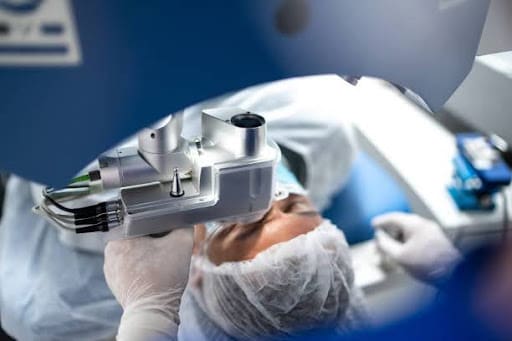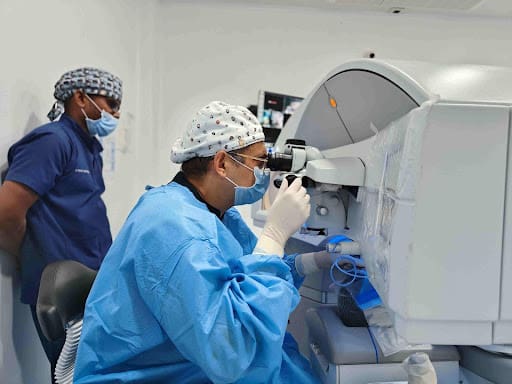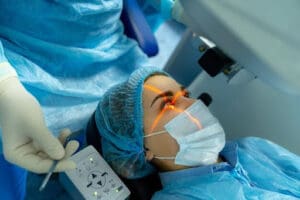The Latest Advances in LASIK Eye
Surgery for Spectacle-Free Vision
- 12 Apr 2023

LASIK eye surgery has become a fantastic solution for getting rid of glasses in a world where good eyesight is essential. This blog explores the newest advancements in LASIK treatment, introduces specialized doctors, explains different types of LASIK procedures, and gives an overall view of the entire process. Let’s dive into the journey towards clear vision and freedom from glasses or contact lenses.
Understanding LASIK Eye Surgery
To start, let’s understand what LASIK is. LASIK, or Laser-Assisted In Situ Keratomileusis, is a modern surgery that helps fix eye problems like nearsightedness, farsightedness, and astigmatism. It aims to make your vision better without needing glasses.The Experts in LASIK Treatment
Choosing the right doctor is crucial when thinking about laser eye surgery. Driven by skill and experience, some well-known eye doctors have pushed LASIK to new levels. Dr. Saurabh Patwardhan and his team stand out for their exceptional talent and knowledge in performing LASIK procedures. A board-certified ophthalmologist focusing on refractive surgery, Dr. Saurabh Patwardhan has successfully transformed the lives of countless patients, making them well-respected in the field.
Types of LASIK Treatments

As LASIK technology is improved, different procedures have come up to help with specific vision problems. Let’s look at some of the latest LASIK treatments:
Traditional LASIK: This time-tested procedure utilizes a microkeratome to create a corneal flap, allowing precise reshaping of the underlying tissue, and giving you better vision. It Is a regular LASIK with Blade.
Bladeless LASIK: Advancing beyond traditional methods, bladeless LASIK utilizes a femtosecond laser to create the corneal flap, enhancing precision and reducing the risk of complications compared to LASIK treatment using a blade.
Flapless SMILE (Small Incision Lenticule Extraction): Small Incision Lenticule Extraction (SMILE ReLEx) is a relatively advanced form of refractive eye surgery for the correction of myopia (nearsightedness) and astigmatism. It involves using a femtosecond laser to create a lenticule within the cornea, which is then removed to reshape the cornea and correct the refractive error.
PRK (Surface Ablation): In PRK, the corneal surface is reshaped without creating a flap. This procedure is suitable for individuals with thin corneas or those who may not be eligible for traditional LASIK. PRK is considered a convenient option for individuals with thinner corneas or those who may not be eligible for LASIK. While the recovery period is longer than LASIK, PRK can provide excellent visual results and is a safe and effective procedure for vision correction.
IPCL (Phakic Contact Lens): The size and power of the IPCL are customized based on the individual’s eye anatomy and refractive error. A small incision is made in the cornea, and the ICL is inserted and placed behind the iris and in front of the natural lens. Recovery time is relatively quick. IPCL surgery is known for providing high-quality vision correction and is reversible if necessary. It is considered an alternative to laser eye surgeries like LASIK and PRK.
It is important to consult with an experienced eye surgeon to determine the most appropriate vision correction procedure based on individual eye health, refractive error, and lifestyle factors. Different lasers may be suitable for different patients, so it is advisable to undergo a pre-LASIK test to decide the best options.

The Benefits of Modern LASIK Technology
The latest advances in LASIK technology bring many advantages for people who want to see without glasses
Better Precision: State-of-the-art lasers and imaging technology tools ensure the cornea is shaped correctly for the best vision.
Quick Recovery: Advanced LASIK procedures often result in faster recovery times, allowing patients to return to their daily activities within two weeks.
Personalized Treatment: Personalized LASIK treatments address individual variations in the corneal structure, giving better results with fewer side effects.
Improved Safety: Evolving safety protocols and refined techniques have made LASIK one of the safest elective surgical procedures, with a low risk of complications.
The LASIK Experience – From Consultation to Recovery
The LASIK journey starts with a thorough checkup where the doctor checks if you’re a good fit for the surgery. Before the surgery, you must stop using contact lenses and take some tests to understand your eye better. On the day of the surgery, it’s a quick and almost painless experience. After the surgery, you might feel a bit uncomfortable, but this doesn’t last long.Taking Care After LASIK and Long-Term Vision
After LASIK, you have to take care of your eyes to ensure they heal properly. You’ll get instructions from eye care experts on using eye drops, avoiding strenuous activities, and coming back for checkups. Most people see a significant improvement in their vision soon after LASIK, with the final results settling in a few weeks. In the long run, vision after LASIK is usually stable, giving you years of clear vision without glasses. But it’s important to keep checking your eyes regularly. In all the LASIK procedures mentioned above, the accuracy to eliminate the need for glasses is up to 97%. After surgery, the chance of getting glasses again is 5% to 7%, which is relatively low. 95% of patients do not need glasses ten years after the surgery.Conclusion:
The array of LASIK treatments, from traditional methods to cutting-edge techniques like Flapless SMILE and IPCL, reflects the continuous technological progress, catering to diverse vision problems and individual preferences.
The benefits of modern LASIK technology, including better precision, quick recovery, personalized treatment, and improved safety, further contribute to the appeal of LASIK as a viable option for vision correction.
To learn more about other eye care treatments, please visit.
Share:
More Posts

Daily Eye Care Routines for Maintaining Good Eye Health

5 Easy Eye Exercises for Reducing Eye Strain

Dry Eye- The Importance of Tears in Maintaining Healthy Eyes







